Search Result
Results for "
ultraviolet
" in MedChemExpress (MCE) Product Catalog:
3
Isotope-Labeled Compounds
| Cat. No. |
Product Name |
Target |
Research Areas |
Chemical Structure |
-
- HY-W014223S1
-
|
ultraviolet absorber UV-0-d5
|
Isotope-Labeled Compounds
|
Others
|
|
(2,4-Dihydroxyphenyl)(phenyl)methanone-d5 is the deuterium labeled (2,4-Dihydroxyphenyl)(phenyl)methanone[1].
|
-

-
- HY-131551
-
|
|
Biochemical Assay Reagents
|
Others
|
|
Drometrizole is a cosmetic ingredient as an ultraviolet light absorber. Drometrizole has no significant toxicity observed in acute oral, inhalation, or dermal toxicity studies .
|
-
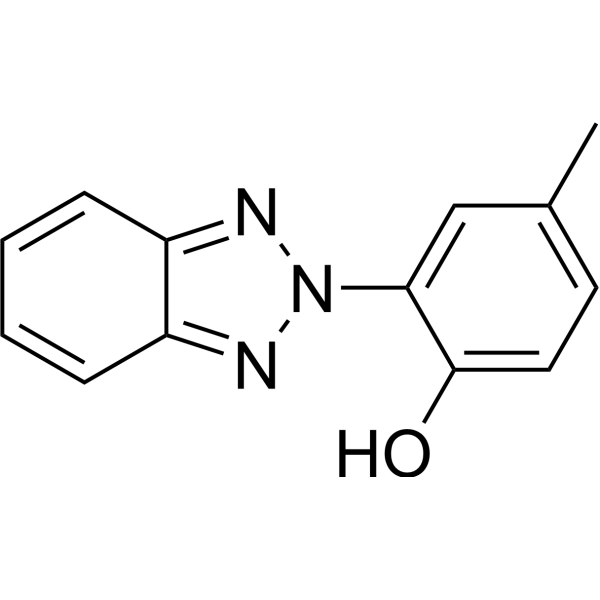
-
- HY-N2460
-
-
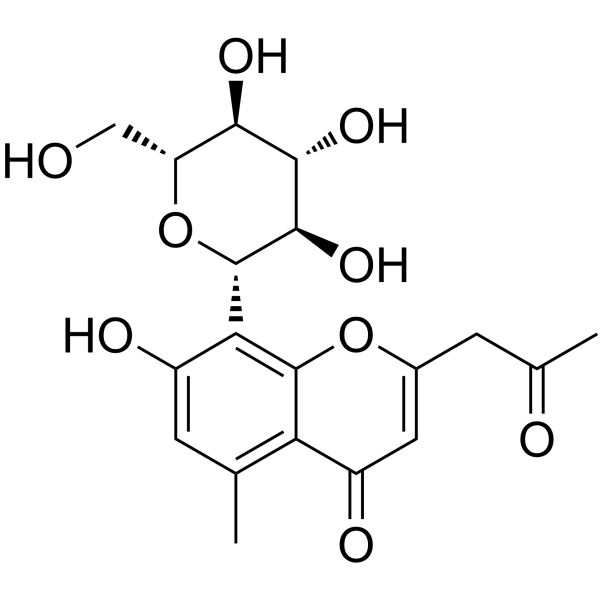
-
- HY-N6095
-
|
|
Others
|
Others
|
|
Nocarimidazole A is a white amorphous solid alkaloid with ultraviolet activity that can be isolated from marine actinomycete Nocardiopsis .
|
-
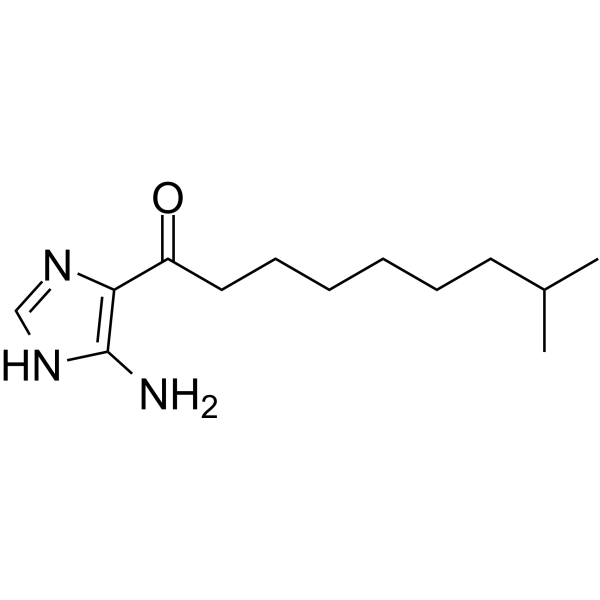
-
- HY-N10228
-
|
|
Endogenous Metabolite
|
Infection
|
|
Gliorosein is a fungal metabolite isolated from Gliocladium. Gliorosein is isomeric with the quinol but shows a different ultraviolet absorption spectrum .
|
-

-
- HY-17587
-
|
4-MBC; Enzacamene
|
Apoptosis
PI3K
Akt
ERK
|
Metabolic Disease
|
|
4-Methylbenzylidene camphor (4-MBC) is an endocrine disrupter that produces estrogen-like effects. 4-Methylbenzylidene camphor decreases the proliferation of human trophoblast cells and induces apoptosis. 4-Methylbenzylidene camphor activates PI3K/AKT and ERK1/2 signaling pathways and elevates intracellular ROS production. 4-Methylbenzylidene camphor is a ultraviolet (UV) filter and may hamper normal placental formation during early pregnancy .
|
-

-
- HY-109655
-
-
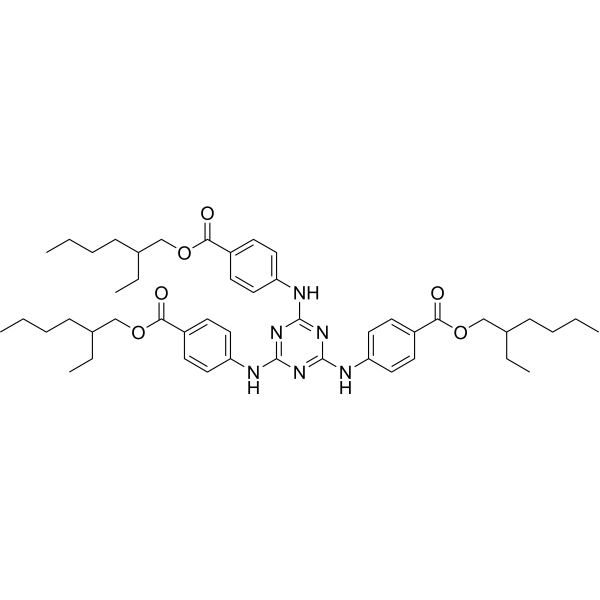
-
- HY-113008
-
|
|
Endogenous Metabolite
|
Cancer
|
|
Urocanic acid, produced in the upper layers of mammalian skin, is a major absorber of ultraviolet radiation (UVR).
|
-
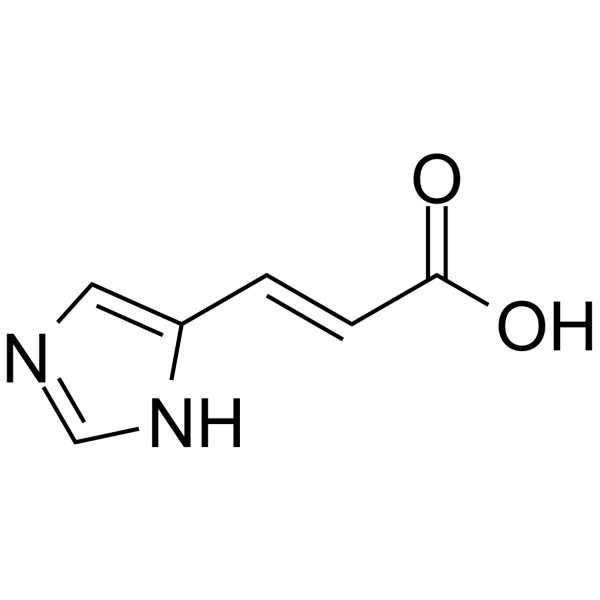
-
- HY-B0966
-
|
Benzophenone-8; UV-24
|
Biochemical Assay Reagents
|
Others
|
|
Dioxybenzone is an organic compound used in sunscreen to block UVB and short-wave UVA (ultraviolet) rays.
|
-
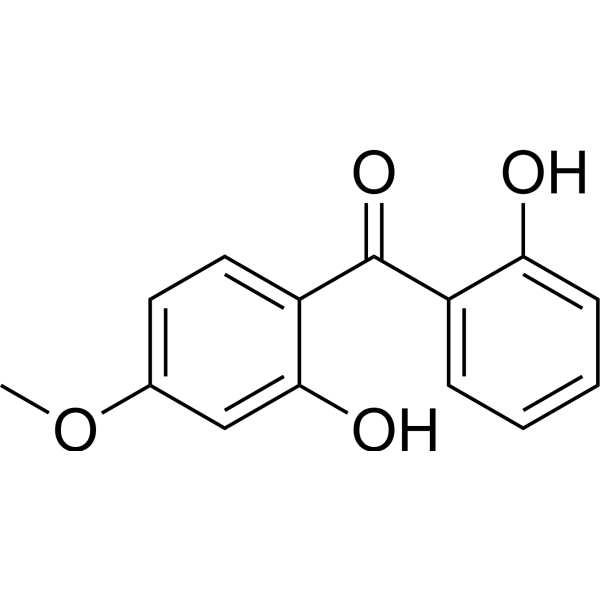
-
- HY-B1162
-
|
Benzophenone-4
|
Biochemical Assay Reagents
|
Others
|
|
Sulisobenzone is an ingredient in some sunscreens which protects the skin from damage by UVB and short-wave UVA ultraviolet light.
|
-
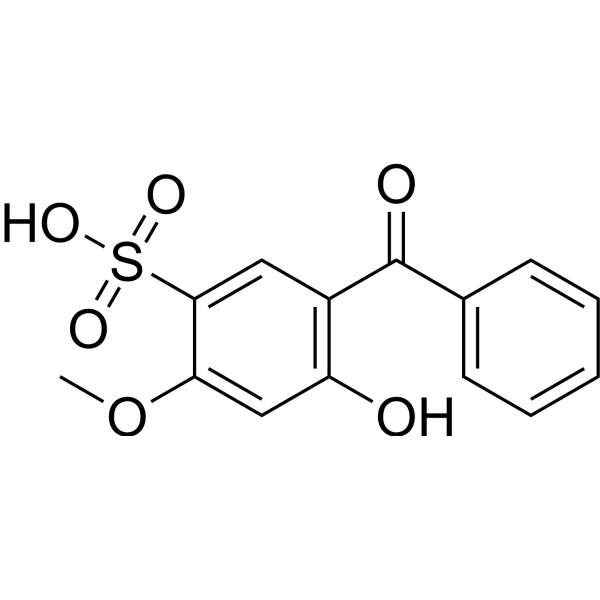
-
- HY-W099730
-
|
Tinosorb S
|
Others
|
Others
|
|
Bemotrizinol (Tinosorb S), an ultraviolet (UV) filter, has been shown to accept atomic oxygen generated by N-oxide photodeoxygenation .
|
-
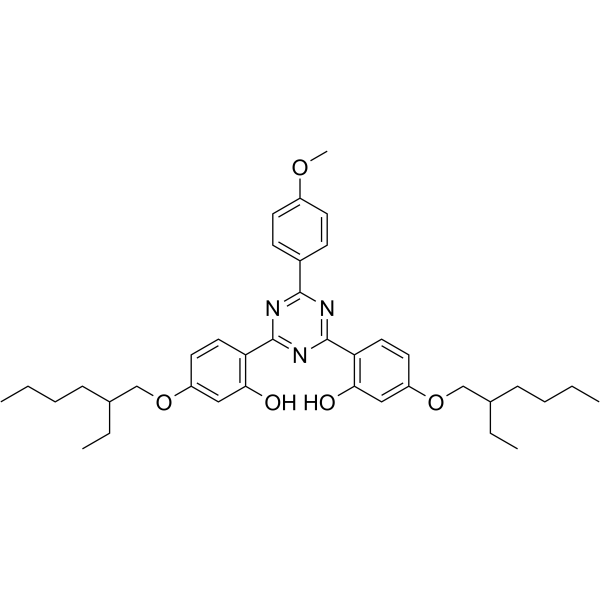
-
- HY-113485
-
Melanin
1 Publications Verification
|
Endogenous Metabolite
|
Others
|
|
Melanin is a unique pigment with myriad functions. It is multifunctional, providing defense against environmental stresses such as ultraviolet (UV) light, oxidizing agents and ionizing radiation.
|
-
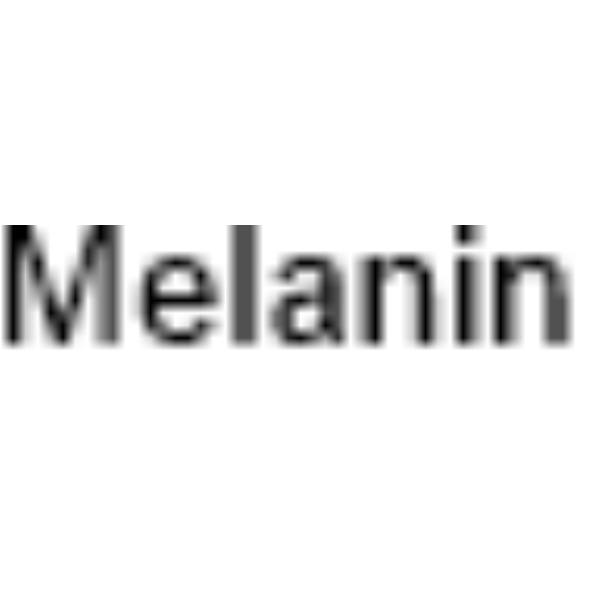
-
- HY-126789
-
|
|
Others
|
Others
|
|
DM-Nitrophen is a Ca 2+ cage. DM-Nitrophen releases Ca 2+ when cleaved upon illumination with near-ultraviolet light .
|
-

-
- HY-N3985
-
|
|
Others
|
Cancer
|
|
Gyrophoric acid is a good ultraviolet filter in lichen populations. Gyrophoric acid shows DPPH radical scavenging activity with an IC50 value of 105.75 µg/ml .
|
-
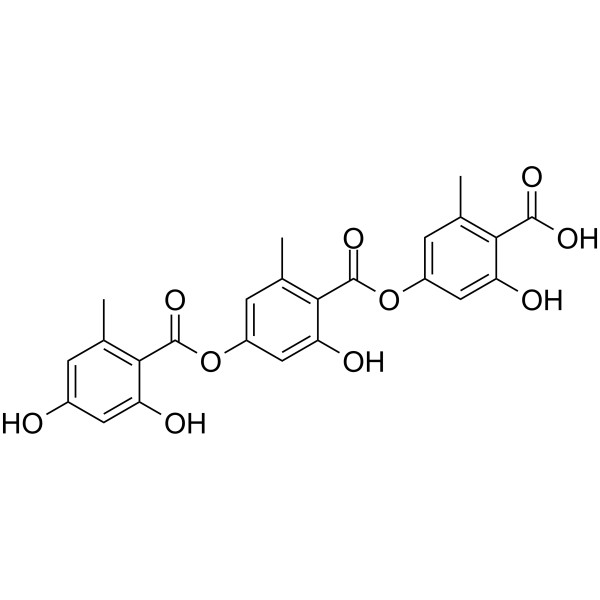
-
- HY-W749966
-
|
|
Isotope-Labeled Compounds
|
Metabolic Disease
|
|
Octocrylene-d10 is the deuterium labeled Octocrylene. Octocrylene is an organic ultraviolet (UV) filter which absorbs mainly UVB radiation and short UVA wavelengths .
|
-
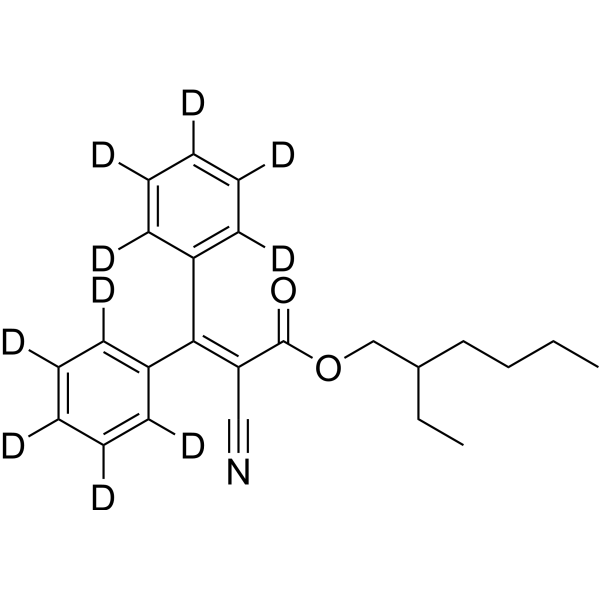
-
- HY-B0966R
-
|
Benzophenone-8 (Standard); UV-24 (Standard)
|
Biochemical Assay Reagents
|
Others
|
|
Dioxybenzone (Standard) is the analytical standard of Dioxybenzone. This product is intended for research and analytical applications. Dioxybenzone is an organic compound used to block UVB and short-wave UVA (ultraviolet) radiation.
|
-
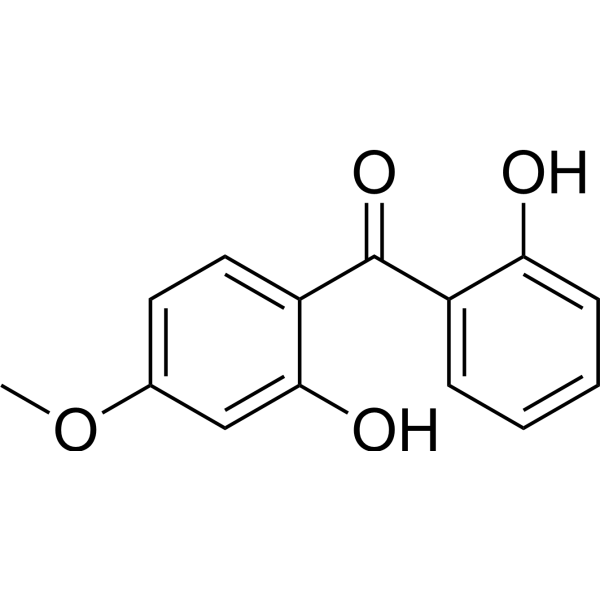
-
- HY-113008S1
-
|
|
Endogenous Metabolite
|
Cancer
|
|
Urocanic acid- 13C3 is the 13C labeled Urocanic acid[1]. Urocanic acid, produced in the upper layers of mammalian skin, is a major absorber of ultraviolet radiation (UVR)[2].
|
-
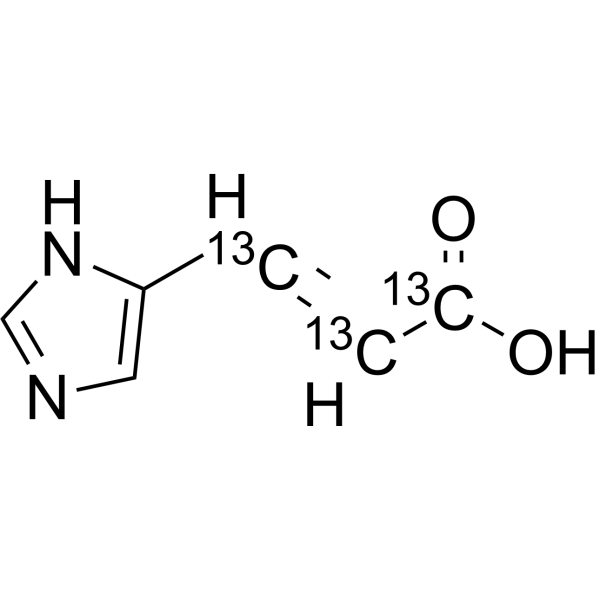
-
- HY-137989
-
|
Voriconazole oxynitride
|
Fungal
|
Infection
|
|
Voriconazole N-oxide (Voriconazole oxynitride) is a potent antifungal agent. Voriconazole N-oxide has phototoxicity and photocarcinogenicity. Voriconazole N-oxide does not sensitize keratinocytes to ultraviolet B (UVB) .
|
-
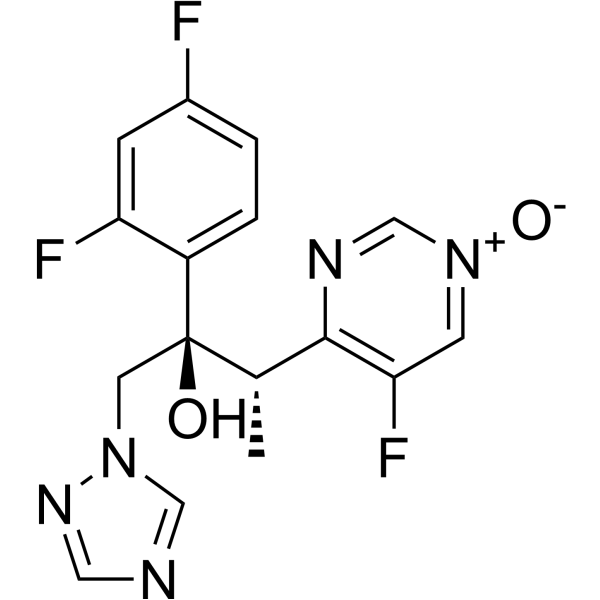
-
- HY-N3925
-
|
|
Bacterial
|
Infection
Metabolic Disease
Inflammation/Immunology
|
|
Ganoderol A is a terpenoid extracted from Ganoderma lucidum with antimicrobial activities. Ganoderol A inhibits cholesterol synthesis pathway and has significant anti-inflammatory activity and protection against ultraviolet A (UVA) damage .
|
-

-
- HY-N4096
-
|
|
Others
|
Inflammation/Immunology
|
|
Tsugaric acid A can significantly inhibit superoxide anion formation. Tsugaric acid A also protects human keratinocytes against damage induced by ultraviolet B (UV B) light. Tsugaric acid A can protect keratinocytes from photodamage.
|
-
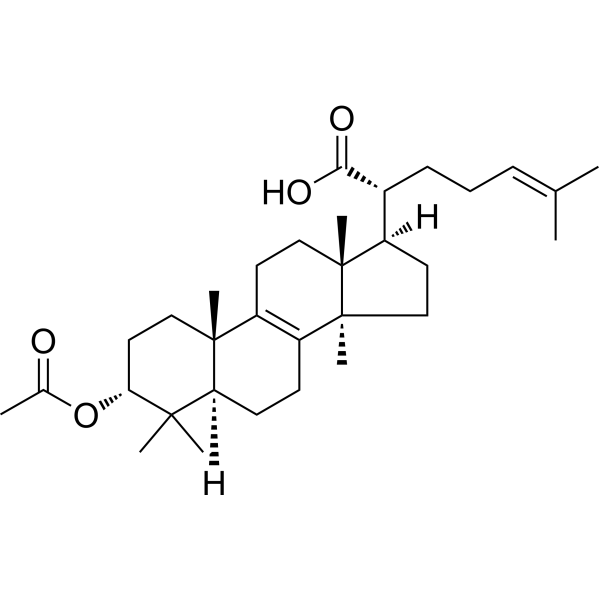
-
- HY-W099730R
-
|
Tinosorb S (Standard)
|
Others
|
Others
|
|
Bemotrizinol (Standard) is the analytical standard of Bemotrizinol. This product is intended for research and analytical applications. Bemotrizinol (Tinosorb S), an ultraviolet (UV) filter, has been shown to accept atomic oxygen generated by N-oxide photodeoxygenation .
|
-
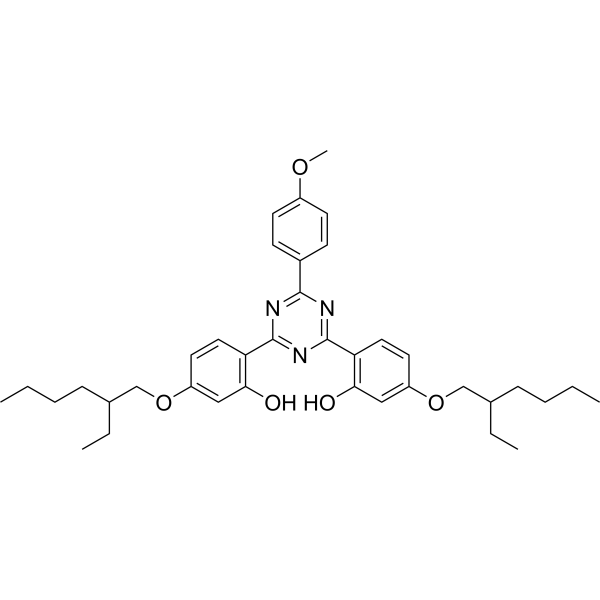
-
- HY-127170
-
|
|
Lipoxygenase
|
Others
|
|
3-hydroxycoumarin is a potent and redox inhibitor of human 15-LOX-1. 3-hydroxycoumarin is recently demonstrated to protect sea urchin reproductive cells against ultraviolet B damage .
|
-
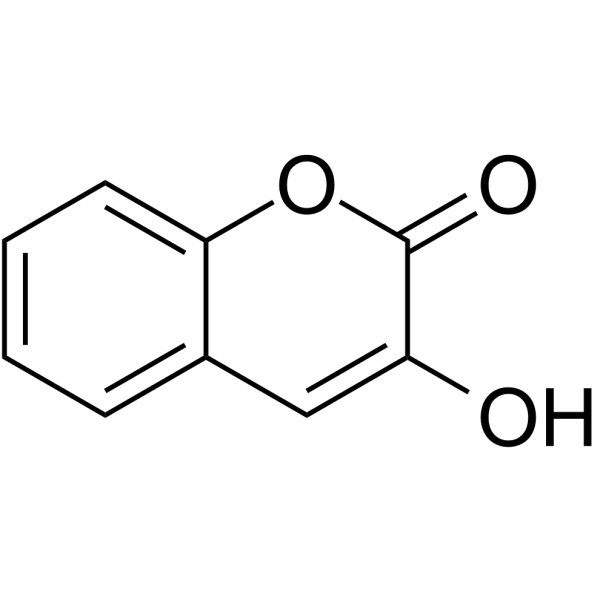
-
- HY-112356
-
|
|
Others
|
Others
|
|
Scytonemin is an ultraviolet sunscreen pigment, that can be isolated from the sheaths of cyanobacteria. Scytonemin displays multiple roles, functioning as a potent UV sunscreen and antioxidant molecules, and can be exploited in cosmetic and other industries for the development of new cosmeceuticals .
|
-
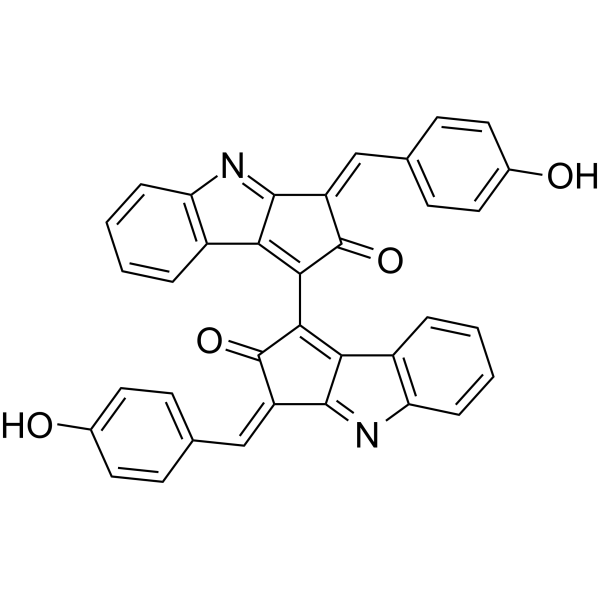
-
- HY-126789A
-
|
|
Others
|
Others
|
|
DM-Nitrophen tertasodium is a Ca 2+ cage. DM-Nitrophen releases Ca 2+ when cleaved upon illumination with near-ultraviolet light . DM-Nitrophen tertasodium can be used for study of Ca 2+ signaling .
|
-
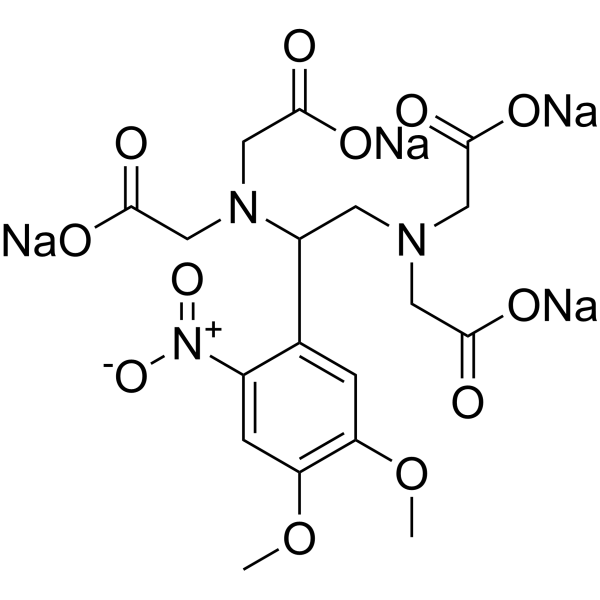
-
- HY-A0087
-
|
|
Biochemical Assay Reagents
|
Others
|
|
Octocrylene is an organic ultraviolet (UV) filter which absorbs mainly UVB radiation and short UVA wavelengths. Octocrylene has the potential for using in various cosmetic products to either provide an appropriate sun protection factor in sunscreen products or to protect cosmetic formulations from UV radiation .
|
-

-
- HY-N0428
-
|
|
Apoptosis
|
Cancer
|
|
Obacunone is a highly oxidized triterpenoid limonoid isolated from citrus plants. Obacunone exerts its anticancer effects by inducing apoptosis. Obacunone also protects retinal pigment epithelial (RPE) cells from ultraviolet (UV) radiation (UVR)-induced oxidative damage .
|
-
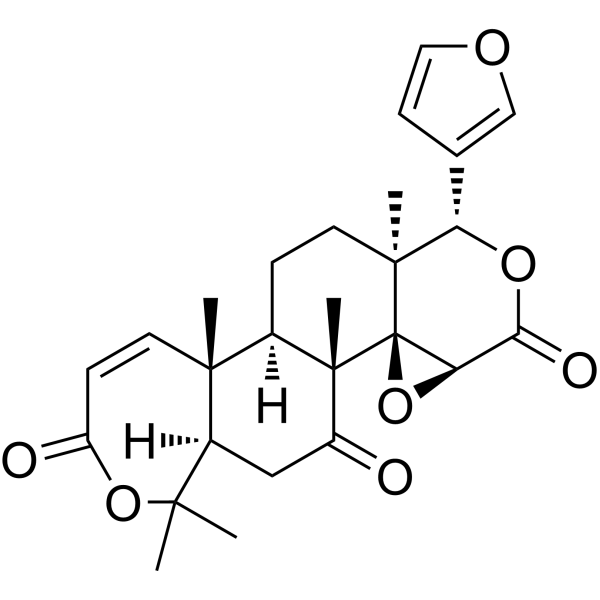
-
- HY-B1157
-
|
Trisoralen; Trioxysalen; TMP
|
DNA Alkylator/Crosslinker
|
Inflammation/Immunology
|
|
Trioxsalen (Trisoralen), a psoralen derivative, is a photochemical DNA crosslinker. Trioxsalen only works after photoactivation with near ultraviolet light. Trioxsalen is a photosensitizer that can be used for the research of vitiligo and hand eczema. Trioxsalen is used for visualization of genomic interstrand cross-links localized by laser photoactivation .
|
-
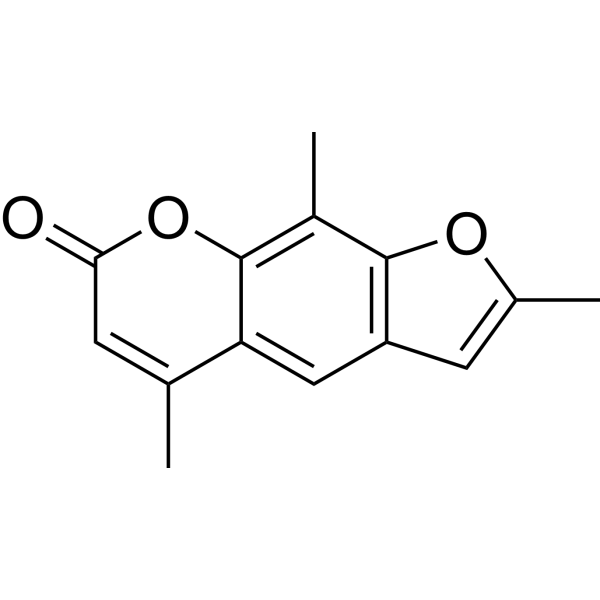
-
- HY-P4400
-
|
|
Fluorescent Dye
|
Others
|
|
Z-VDVAD-AFC is a fluorogenic substrate. Z-VDVAD-AFC is used to measure the activity of cysteine protease 3 (Caspase-3). Z-VDVAD-AFC undergoes hydrolysis to release 7-amino-4-trifluoromethylcoumarin (AFC). AFC is fluorescent under ultraviolet light and can emit fluorescent signals .
|
-
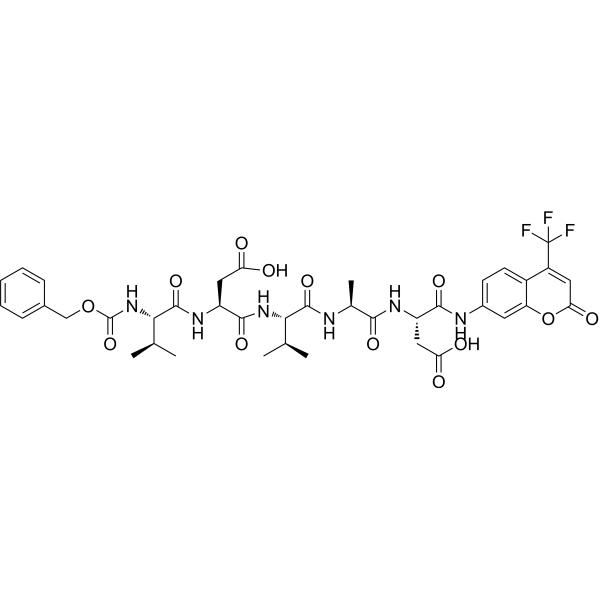
-
- HY-N7171
-
|
4,4'-DiOMEA; Nasutin C
|
Wnt
|
Cancer
|
|
4,4'-Di-O-methylellagic acid (4,4'-DiOMEA; Nasutin C) can be isolated from the Australian termites. 4,4'-Di-O-methylellagic acid is blue-fluorescent under ultra-violet light . 4,4'-Di-O-methylellagic acid inhibits colon cancer cell proliferation via the wnt signal pathway .
|
-
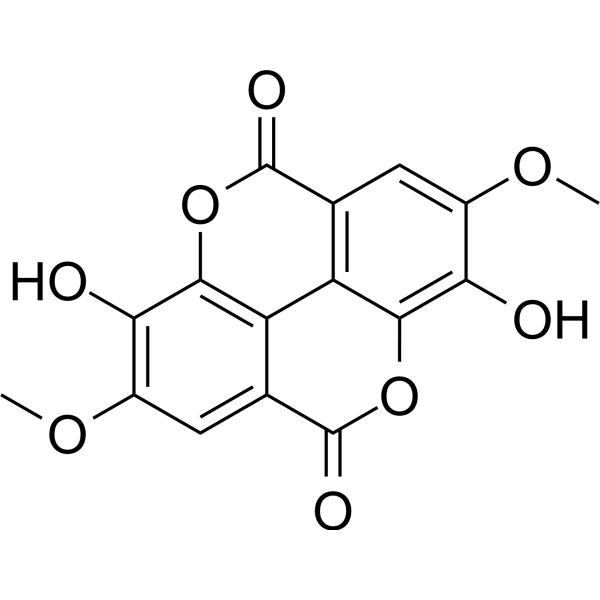
-
- HY-B1156
-
|
Cefradine; SQ-11436
|
Bacterial
Antibiotic
TOPK
|
Infection
Inflammation/Immunology
|
|
Cephradine (Cefradine) is a broad-spectrum and orally active cephalosporin. Cephradine is active against both gram-positive and gram-negative pathogens. Cephradine is effective in eradicating most penicillinase-producing organisms. Cephradine has been used in the research of genitourinary, gastrointestinal and respiratory tract infections, and in infections of the skin and soft tissues. Cephradine blocks solar-ultraviolet induced skin inflammation through direct inhibition of TOPK .
|
-
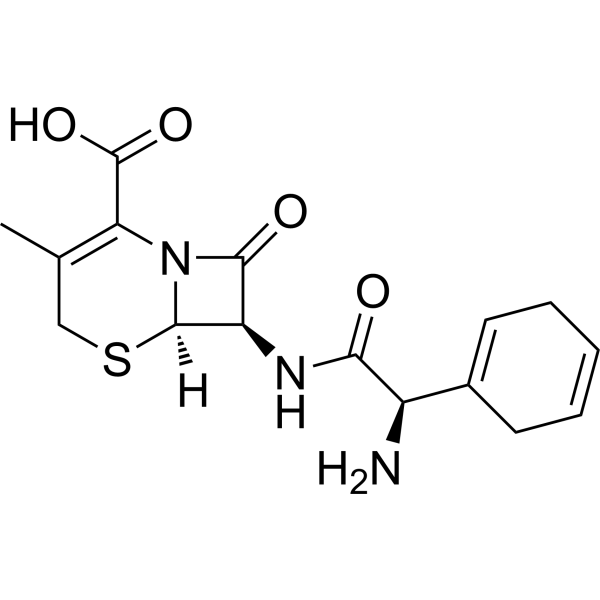
-
- HY-128449
-
|
Cefradine monohydrate
|
Bacterial
Antibiotic
TOPK
|
Infection
Inflammation/Immunology
|
|
Cephradine (Cefradine) monohydrate is a broad-spectrum and orally active cephalosporin. Cephradine monohydrate is active against both grampositive and gram-negative pathogens and effective in eradicating most penicillinase-producing organisms known to be resistant to penicillin G, penicillin V, and ampicillin. Cephradine monohydrate has been used in the research of genitourinary, gastrointestinal and respiratory tract infections, and in infections of the skin and soft tissues. Cephradine monohydrate blocks solar-ultraviolet induced skin inflammation through direct inhibition of TOPK .
|
-

-
- HY-D1106
-
|
|
Fluorescent Dye
|
Cancer
|
|
BODIPY dye is a small molecule dye with strong ultraviolet absorption ability, its fluorescence peak is relatively sharp, and the quantum yield is high. They are relatively insensitive to the polarity and pH of the environment and are relatively stable under different physiological conditions . Due to its structural asymmetry, BODIPY derives a variety of structural products. BODIPY lipid droplet dyes can well pass through the cell membrane into the cell, and localize the polar lipids in the cell to specifically stain the lipid droplets, which can be used for labeling of live cells and fixed cells .
|
-
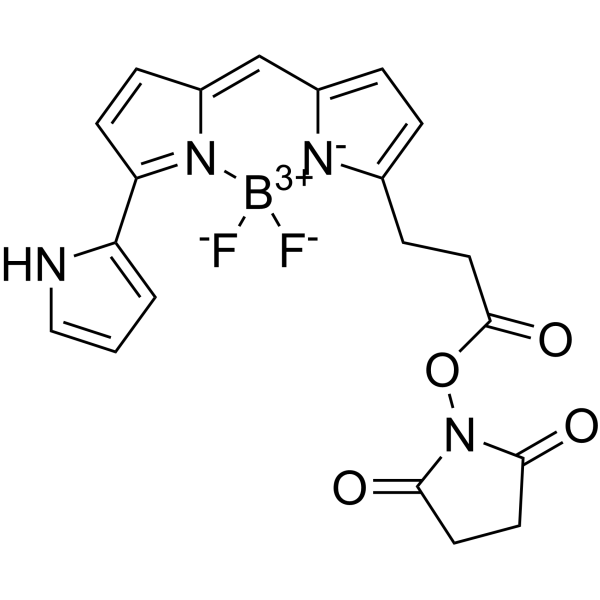
-
- HY-D1237
-
|
|
Fluorescent Dye
|
Metabolic Disease
|
|
BODIPY505/515 is a BODIPY dye. BODIPY dye is a small molecule dye with strong ultraviolet absorption ability, its fluorescence peak is relatively sharp, and the quantum yield is high. They are relatively insensitive to the polarity and pH of the environment and are relatively stable under different physiological conditions. Due to its structural asymmetry, BODIPY derives a variety of structural products. BODIPY lipid droplet dyes can well pass through the cell membrane into the cell, and localize the polar lipids in the cell to specifically stain the lipid droplets, which can be used for labeling of live cells and fixed cells . Maximum excitation/emission wavelength: 505/515 nm .
|
-
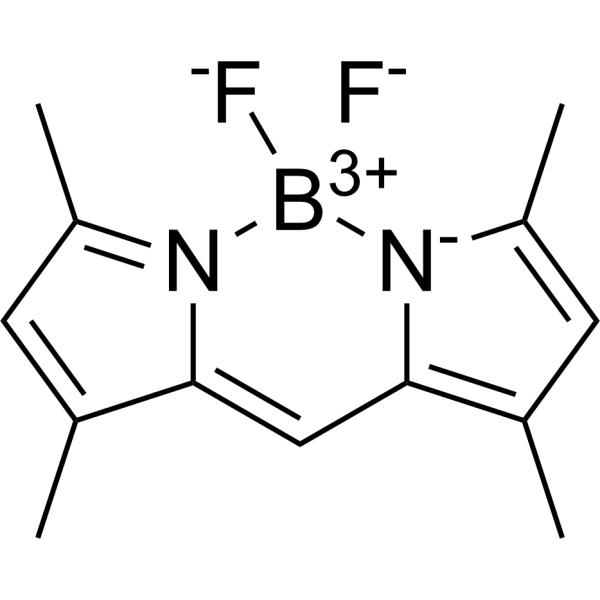
-
- HY-D1570
-
|
|
Fluorescent Dye
|
Others
|
|
BODIPYFL C12 is a BODIPY dye. BODIPY dye is a small molecule dye with strong ultraviolet absorption ability, its fluorescence peak is relatively sharp, and the quantum yield is high. They are relatively insensitive to the polarity and pH of the environment and are relatively stable under different physiological conditions. Due to its structural asymmetry, BODIPY derives a variety of structural products. BODIPY lipid droplet dyes can well pass through the cell membrane into the cell, and localize the polar lipids in the cell to specifically stain the lipid droplets, which can be used for labeling of live cells and fixed cells . Maximum excitation/emission wavelength: 480/508 nm .
|
-

-
- HY-W090090
-
|
Pyrromethene 546; BDP 493/503 lipid stain
|
Fluorescent Dye
|
Others
|
|
BODIPY493/503 is a BODIPY dye. BODIPY dye is a small molecule dye with strong ultraviolet absorption ability, its fluorescence peak is relatively sharp, and the quantum yield is high. They are relatively insensitive to the polarity and pH of the environment and are relatively stable under different physiological conditions. Due to its structural asymmetry, BODIPY derives a variety of structural products. BODIPY lipid droplet dyes can well pass through the cell membrane into the cell, and localize the polar lipids in the cell to specifically stain the lipid droplets, which can be used for labeling of live cells and fixed cells . Maximum excitation/emission wavelength: 493/503 nm .
|
-

-
- HY-138226
-
|
|
Fluorescent Dye
|
Others
|
|
BODIPY 558/568 C12 is a BODIPY dye. BODIPY dye is a small molecule dye with strong ultraviolet absorption ability, its fluorescence peak is relatively sharp, and the quantum yield is high. They are relatively insensitive to the polarity and pH of the environment and are relatively stable under different physiological conditions. Due to its structural asymmetry, BODIPY derives a variety of structural products. BODIPY lipid droplet dyes can well pass through the cell membrane into the cell, and localize the polar lipids in the cell to specifically stain the lipid droplets, which can be used for labeling of live cells and fixed cells . Maximum excitation/emission wavelength: 558/568 nm .
|
-

-
- HY-D1614
-
|
|
Fluorescent Dye
|
Others
|
|
BODIPY493/503 methyl bromide is a BODIPY dye. BODIPY dye is a small molecule dye with strong ultraviolet absorption ability, its fluorescence peak is relatively sharp, and the quantum yield is high. They are relatively insensitive to the polarity and pH of the environment and are relatively stable under different physiological conditions. Due to its structural asymmetry, BODIPY derives a variety of structural products. BODIPY lipid droplet dyes can well pass through the cell membrane into the cell, and localize the polar lipids in the cell to specifically stain the lipid droplets, which can be used for labeling of live cells and fixed cells . Maximum excitation/emission wavelength: 493/503 nm .
|
-

-
- HY-D1617
-
|
|
Fluorescent Dye
|
Others
|
|
BODIPY 500/510 C1, C12 is a BODIPY dye. BODIPY dye is a small molecule dye with strong ultraviolet absorption ability, its fluorescence peak is relatively sharp, and the quantum yield is high. They are relatively insensitive to the polarity and pH of the environment and are relatively stable under different physiological conditions. Due to its structural asymmetry, BODIPY derives a variety of structural products. BODIPY lipid droplet dyes can well pass through the cell membrane into the cell, and localize the polar lipids in the cell to specifically stain the lipid droplets, which can be used for labeling of live cells and fixed cells . Maximum excitation/emission wavelength: 500/510 nm . Protect from light, stored at -20℃.
|
-

| Cat. No. |
Product Name |
Type |
-
- HY-D1106
-
|
|
Fluorescent Dyes/Probes
|
|
BODIPY dye is a small molecule dye with strong ultraviolet absorption ability, its fluorescence peak is relatively sharp, and the quantum yield is high. They are relatively insensitive to the polarity and pH of the environment and are relatively stable under different physiological conditions . Due to its structural asymmetry, BODIPY derives a variety of structural products. BODIPY lipid droplet dyes can well pass through the cell membrane into the cell, and localize the polar lipids in the cell to specifically stain the lipid droplets, which can be used for labeling of live cells and fixed cells .
|
-
- HY-D1237
-
|
|
Fluorescent Dyes/Probes
|
|
BODIPY505/515 is a BODIPY dye. BODIPY dye is a small molecule dye with strong ultraviolet absorption ability, its fluorescence peak is relatively sharp, and the quantum yield is high. They are relatively insensitive to the polarity and pH of the environment and are relatively stable under different physiological conditions. Due to its structural asymmetry, BODIPY derives a variety of structural products. BODIPY lipid droplet dyes can well pass through the cell membrane into the cell, and localize the polar lipids in the cell to specifically stain the lipid droplets, which can be used for labeling of live cells and fixed cells . Maximum excitation/emission wavelength: 505/515 nm .
|
-
- HY-W090090
-
|
Pyrromethene 546; BDP 493/503 lipid stain
|
Fluorescent Dyes/Probes
|
|
BODIPY493/503 is a BODIPY dye. BODIPY dye is a small molecule dye with strong ultraviolet absorption ability, its fluorescence peak is relatively sharp, and the quantum yield is high. They are relatively insensitive to the polarity and pH of the environment and are relatively stable under different physiological conditions. Due to its structural asymmetry, BODIPY derives a variety of structural products. BODIPY lipid droplet dyes can well pass through the cell membrane into the cell, and localize the polar lipids in the cell to specifically stain the lipid droplets, which can be used for labeling of live cells and fixed cells . Maximum excitation/emission wavelength: 493/503 nm .
|
-
- HY-138226
-
|
|
Fluorescent Dyes/Probes
|
|
BODIPY 558/568 C12 is a BODIPY dye. BODIPY dye is a small molecule dye with strong ultraviolet absorption ability, its fluorescence peak is relatively sharp, and the quantum yield is high. They are relatively insensitive to the polarity and pH of the environment and are relatively stable under different physiological conditions. Due to its structural asymmetry, BODIPY derives a variety of structural products. BODIPY lipid droplet dyes can well pass through the cell membrane into the cell, and localize the polar lipids in the cell to specifically stain the lipid droplets, which can be used for labeling of live cells and fixed cells . Maximum excitation/emission wavelength: 558/568 nm .
|
-
- HY-D1570
-
|
|
Fluorescent Dyes/Probes
|
|
BODIPYFL C12 is a BODIPY dye. BODIPY dye is a small molecule dye with strong ultraviolet absorption ability, its fluorescence peak is relatively sharp, and the quantum yield is high. They are relatively insensitive to the polarity and pH of the environment and are relatively stable under different physiological conditions. Due to its structural asymmetry, BODIPY derives a variety of structural products. BODIPY lipid droplet dyes can well pass through the cell membrane into the cell, and localize the polar lipids in the cell to specifically stain the lipid droplets, which can be used for labeling of live cells and fixed cells . Maximum excitation/emission wavelength: 480/508 nm .
|
-
- HY-D1614
-
|
|
Fluorescent Dyes/Probes
|
|
BODIPY493/503 methyl bromide is a BODIPY dye. BODIPY dye is a small molecule dye with strong ultraviolet absorption ability, its fluorescence peak is relatively sharp, and the quantum yield is high. They are relatively insensitive to the polarity and pH of the environment and are relatively stable under different physiological conditions. Due to its structural asymmetry, BODIPY derives a variety of structural products. BODIPY lipid droplet dyes can well pass through the cell membrane into the cell, and localize the polar lipids in the cell to specifically stain the lipid droplets, which can be used for labeling of live cells and fixed cells . Maximum excitation/emission wavelength: 493/503 nm .
|
-
- HY-D1617
-
|
|
Fluorescent Dyes/Probes
|
|
BODIPY 500/510 C1, C12 is a BODIPY dye. BODIPY dye is a small molecule dye with strong ultraviolet absorption ability, its fluorescence peak is relatively sharp, and the quantum yield is high. They are relatively insensitive to the polarity and pH of the environment and are relatively stable under different physiological conditions. Due to its structural asymmetry, BODIPY derives a variety of structural products. BODIPY lipid droplet dyes can well pass through the cell membrane into the cell, and localize the polar lipids in the cell to specifically stain the lipid droplets, which can be used for labeling of live cells and fixed cells . Maximum excitation/emission wavelength: 500/510 nm . Protect from light, stored at -20℃.
|
| Cat. No. |
Product Name |
Target |
Research Area |
-
- HY-P4465
-
|
|
Peptides
|
Others
|
|
Gly-Arg-pNA is a fluorogenic substrate for the measurement of protease activity. Gly-Arg-pNA undergoes hydrolysis and releases the fluorescent product p-nitroaniline. p-nitroaniline is in a fluorescent state under ultraviolet light irradiation and can emit a fluorescent signal .
|
-
- HY-P4406
-
|
|
Peptides
|
Others
|
|
Abz-AGLA-Nba is a fluorogenic substrate for the determination of protease activity. Abz-AGLA-Nba is hydrolyzed to release aminoacyl benzimide (Abz-AGLA) and 2-naphthylaminoacyl (Nba). The product Abz-AGLA produced by this hydrolysis reaction is fluorescent under ultraviolet light and can emit a fluorescent signal .
|
-
- HY-P4400
-
|
|
Fluorescent Dye
|
Others
|
|
Z-VDVAD-AFC is a fluorogenic substrate. Z-VDVAD-AFC is used to measure the activity of cysteine protease 3 (Caspase-3). Z-VDVAD-AFC undergoes hydrolysis to release 7-amino-4-trifluoromethylcoumarin (AFC). AFC is fluorescent under ultraviolet light and can emit fluorescent signals .
|
-
- HY-P4404
-
|
|
Peptides
|
Others
|
|
Abz-GIVRAK(Dnp) is the most efficient substrate for cathepsin B and is highly selective for this enzyme among lysosomal cysteine proteases. After Abz-GIVRAK(Dnp) is hydrolyzed, aminoacylbenziminosulfosuccinic acid (Abz-SAS) is released, and dinitrobenzoyl (Dnp) is also released. The product of this hydrolysis reaction, Abz-SAS, is fluorescent under ultraviolet light and can emit a fluorescent signal .
|
| Cat. No. |
Product Name |
Category |
Target |
Chemical Structure |
| Cat. No. |
Product Name |
Chemical Structure |
-
- HY-W014223S1
-
|
|
|
(2,4-Dihydroxyphenyl)(phenyl)methanone-d5 is the deuterium labeled (2,4-Dihydroxyphenyl)(phenyl)methanone[1].
|
-

-
- HY-W749966
-
|
|
|
Octocrylene-d10 is the deuterium labeled Octocrylene. Octocrylene is an organic ultraviolet (UV) filter which absorbs mainly UVB radiation and short UVA wavelengths .
|
-

-
- HY-113008S1
-
|
|
|
Urocanic acid- 13C3 is the 13C labeled Urocanic acid[1]. Urocanic acid, produced in the upper layers of mammalian skin, is a major absorber of ultraviolet radiation (UVR)[2].
|
-

Your information is safe with us. * Required Fields.
Inquiry Information
- Product Name:
- Cat. No.:
- Quantity:
- MCE Japan Authorized Agent:














































